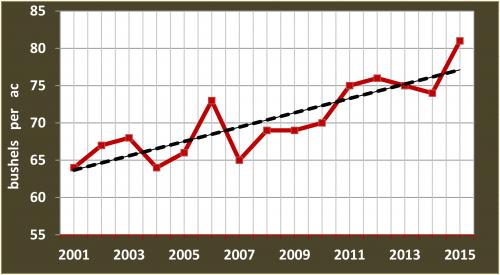Michigan wheat growers set record yields in 2015
Many Michigan wheat growers enjoyed strong yields this past season and are hoping for encore performances in years to come.

Michigan winter wheat growers achieved the highest average yields in the state’s history during the 2015 season. According to the USDA Small Grains 2015 Summary, the 81-bushels-per-acre-yield topped the previous record of 76 bushels set in 2012. The 2015 yield also establishes Michigan as having the highest non-irrigated wheat yields in the United States. These records occurred despite late planting dates in fall of 2014 and a severe yield-limiting weather pattern in southern Michigan.
As shown in the diagram below, yields had plateaued around 75 bushels before the 2015 crop was able to break the imaginary ceiling and support a trend line that suggests an average annual yield improvement of nearly one bushel. With this strong performance, the question of how to surpass the 81-bushel mark is unavoidable. Of course, the recipe for high yields (and profitable yields) requires a generous portion of favorable weather this winter and throughout the 2016 growing season. Beyond this, and to the extent they have some influence, producers would do well to continue honing those production practices and inputs that have proved effective in recent years, including:
- Early planting dates. Arguably, one of the most cost-effective measures for improving wheat yields is to plant relatively early (the latter half of September to the first week of October for central Michigan). This may involve adjusting your rotation or, more often, planting an earlier maturing soybean variety that would allow earlier harvest and, in turn, earlier wheat planting.
- Seedling establishment. Over the past several years, growers have justifiably placed greater emphasis on achieving more uniform stands in fall by better managing residue from the previous crop and using newer grain drills. These strong stands represent the foundation for achieving optimum wheat performance.
- Using fungicides. Based on Michigan State University Extension research and growers’ experiences, the use of fungicides to limit leaf diseases has led to the greatest boost to wheat yields in recent years. The greatest return has been where Prosaro or Caramba fungicides have been applied a few days after the wheat heads fully emerged from the sheath. While this practice usually bumps yields by 4 to 10 percent, the application provides the added benefit of reducing Fusarium head scab and, in turn, vomitoxin levels.
- Managing nitrogen fertilizer. Growers, in general, have tightened their nitrogen management. Continued improvements related to product applications and a fine-tuning of nitrogen rates are likely to further insure profitable wheat yields.
- Variety selection. Without the benefit of hybridization or genetic engineering, wheat breeding has not improved yields to the extent it has in some other crops. Nevertheless, new varieties need to be evaluated and potentially adopted as they usually out-perform older varieties. More importantly, in the next few years growers are likely to see many more varieties containing significantly improved disease resistance – particularly Fusarium head scab. This development will help reduce production risks and ultimately improve grower’s bottom line.

Michigan wheat yields, 2001-2015
Beyond these yield-winning practices, growers might do well to continue supporting wheat research and education. One potential avenue is through the Michigan Wheat Program, whose mission is to promote the profitable production of wheat in Michigan. This program is currently holding a continuation referendum and growers are encouraged to vote. The ballot, which should have been received in the mail from Michigan Department of Agriculture and Rural Development, needs to be completed and postmarked by Jan. 22, 2016.



 Print
Print Email
Email